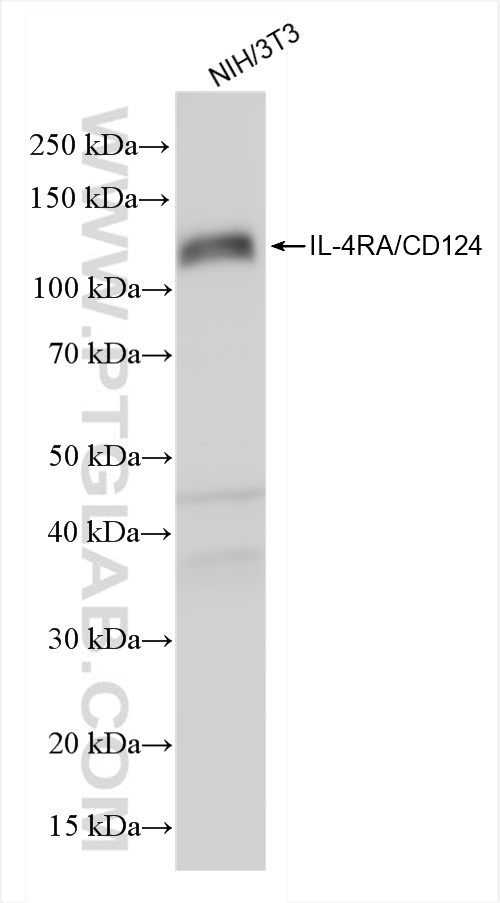验证数据展示
经过测试的应用
| Positive WB detected in | NIH/3T3 cells |
推荐稀释比
| 应用 | 推荐稀释比 |
|---|---|
| Western Blot (WB) | WB : 1:1000-1:4000 |
| It is recommended that this reagent should be titrated in each testing system to obtain optimal results. | |
| Sample-dependent, Check data in validation data gallery. | |
产品信息
84758-5-RR targets IL-4 R alpha/CD124 in WB, ELISA applications and shows reactivity with mouse samples.
| 经测试应用 | WB, ELISA Application Description |
| 经测试反应性 | mouse |
| 免疫原 | Recombinant protein 种属同源性预测 |
| 宿主/亚型 | Rabbit / IgG |
| 抗体类别 | Recombinant |
| 产品类型 | Antibody |
| 全称 | interleukin 4 receptor, alpha |
| 别名 | Il4ra, IL-4R subunit alpha, Il4r, IL-4 receptor subunit alpha, CD124 |
| 计算分子量 | 88 kDa |
| 观测分子量 | 130 kDa |
| GenBank蛋白编号 | NM_001008700.3 |
| 基因名称 | Il4ra |
| Gene ID (NCBI) | 16190 |
| 偶联类型 | Unconjugated |
| 形式 | Liquid |
| 纯化方式 | Protein A purfication |
| UNIPROT ID | P16382-1 |
| 储存缓冲液 | PBS with 0.02% sodium azide and 50% glycerol , pH 7.3 |
| 储存条件 | Store at -20°C. Stable for one year after shipment. Aliquoting is unnecessary for -20oC storage. |
背景介绍
IL-4 receptor alpha chain (IL-4RA), also known as CD124, is a transmembrane glycoprotein expressed on a wide variety of hematopoietic and non-hematopoietic cells. It is a receptor for both IL-4 and IL-13. IL-4RA can complex with the common gamma chain (IL-2R gamma or CD132) and utilizes JAK1 and JAK2 for signal transduction, while complexes of IL-4RA with IL-13RA1 subunit mediate signals via JAK2 and Tyk2. The IL-4 response is involved in promoting Th2 differentiation. The IL-4/IL-13 responses are involved in regulating IgE production and, chemokine and mucus production at sites of allergic inflammation.
实验方案
| Product Specific Protocols | |
|---|---|
| WB protocol for IL-4 R alpha/CD124 antibody 84758-5-RR | Download protocol |
| Standard Protocols | |
|---|---|
| Click here to view our Standard Protocols |
